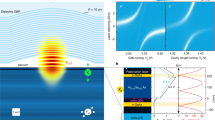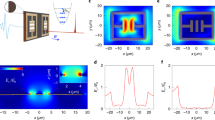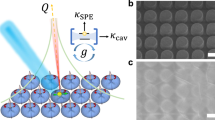Abstract
Cavity quantum electrodynamics (QED) systems allow the study of a variety of fundamental quantum-optics phenomena, such as entanglement, quantum decoherence and the quantum–classical boundary1,2,3,4,5,6,7,8,9. Such systems also provide test beds for quantum information science. Nearly all strongly coupled cavity QED experiments have used a single atom in a high-quality-factor (high-Q) cavity. Here we report the experimental realization of a strongly coupled system in the solid state: a single quantum dot embedded in the spacer of a nanocavity, showing vacuum-field Rabi splitting exceeding the decoherence linewidths of both the nanocavity and the quantum dot. This requires a small-volume cavity and an atomic-like two-level system5,10. The photonic crystal11 slab nanocavity—which traps photons when a defect is introduced inside the two-dimensional photonic bandgap by leaving out one or more holes12—has both high Q and small modal volume V, as required for strong light–matter interactions13. The quantum dot has two discrete energy levels with a transition dipole moment much larger than that of an atom14,15,16, and it is fixed in the nanocavity during growth.
This is a preview of subscription content, access via your institution
Access options
Subscribe to this journal
Receive 51 print issues and online access
$199.00 per year
only $3.90 per issue
Buy this article
- Purchase on Springer Link
- Instant access to full article PDF
Prices may be subject to local taxes which are calculated during checkout




Similar content being viewed by others
References
Berman, P. (ed.) Cavity Quantum Electrodynamics (Academic, San Diego, 1994)
Brune, M. et al. Quantum Rabi oscillations: A direct test of field quantization in a cavity. Phys. Rev. Lett. 76, 1800–1803 (1996)
Haroche, S. Entanglement, decoherence, and the quantum/classical boundary. Phys. Today 36–42 (July 1998)
Raimond, J. M., Brune, M. & Haroche, S. Colloquium: Manipulating quantum entanglement with atoms and photons in a cavity. Rev. Mod. Phys. 73, 565–582 (2001)
Mabuchi, H. & Doherty, A. C. Cavity quantum electrodynamics: Coherence in context. Science 298, 1372–1377 (2002)
McKeever, J., Boca, A., Boozer, A. D., Buck, J. R. & Kimble, H. J. Experimental realization of a one-atom laser in the regime of strong coupling. Nature 425, 268–271 (2003)
Keller, M., Lange, B., Hayasaka, K., Lange, W. & Walther, H. Deterministic coupling of single ions to an optical cavity. Appl. Phys. B 76, 125–128 (2003)
Kreuter, A. et al. Spontaneous emission lifetime of a single trapped Ca+ ion in a high finesse cavity. Phys. Rev. Lett. 92, 203002 (2004)
Wallraff, A. et al. Strong coupling of a single photon to a superconducting qubit using circuit quantum electrodynamics. Nature 431, 162–167 (2004)
Khitrova, G., Gibbs, H. M., Jahnke, F., Kira, M. & Koch, S. W. Nonlinear optics of normal-mode-coupling semiconductor microcavities. Rev. Mod. Phys. 71, 1591–1639 (1999)
Yablonovitch, E. Inhibited spontaneous emission in solid-state physics and electronics. Phys. Rev. Lett. 58, 2059–2062 (1987)
Painter, O. et al. Two-dimensional photonic band-gap defect mode laser. Science 284, 1819–1821 (1999)
Akahane, Y., Asano, T., Song, B.-S. & Noda, S. High-Q photonic nanocavity in a two-dimensional photonic crystal. Nature 425, 944–947 (2003)
Marzin, J.-Y., Gérard, J.-M., Izraël, A., Barrier, D. & Bastard, G. Photoluminescence of single InAs quantum dots obtained by self-organized growth on GaAs. Phys. Rev. Lett. 73, 716–719 (1994)
Brunner, K., Abstreiter, G., Böhm, G., Tränkle, G. & Weimann, G. Sharp-line photoluminescence and two-photon absorption of zero-dimensional biexcitons in a GaAs/AlGaAs structure. Phys. Rev. Lett. 73, 1138–1141 (1994)
Gammon, D. & Steel, D. G. Optical studies of single quantum dots. Phys. Today 36–41 (October 2002)
Weisbuch, C., Nishioka, M., Ishikawa, A. & Arakawa, Y. Observation of the coupled exciton-photon mode splitting in a semiconductor quantum microcavity. Phys. Rev. Lett. 69, 3314–3317 (1992)
Gammon, D., Snow, E. S., Shanabrook, B. V., Katzer, D. S. & Park, D. Fine structure in the optical spectra of single GaAs quantum dots. Phys. Rev. Lett. 76, 3005–3008 (1996)
Petroff, P. M., Lorke, A. & Imamoglu, A. Epitaxially self-assembled quantum dots. Phys. Today 46–52 (May 2001)
Zrenner, A. et al. Coherent properties of a two-level system based on a quantum-dot photodiode. Nature 418, 612–614 (2002)
Moreau, E. et al. Single-mode solid-state single photon source based on isolated quantum dots in pillar microcavities. Appl. Phys. Lett. 79, 2865–2867 (2001)
Bayer, M. et al. Inhibition and enhancement of the spontaneous emission of quantum dots in structured microcavities. Phys. Rev. Lett. 86, 3168–3171 (2001)
Happ, T. D. et al. Enhanced light emission of InxGa1-xAs quantum dots in a two-dimensional photonic-crystal defect microcavity. Phys. Rev. B 66, 041303(R) (2002)
Vahala, K. J. Optical microcavities. Nature 424, 839–846 (2003)
Santori, C., Fattal, D., Vučković, J., Solomon, G. S. & Yamamoto, Y. Indistinguishable photons from a single-photon device. Nature 419, 594–597 (2002)
Yoshie, T., Shchekin, O. B., Chen, H., Deppe, D. G. & Scherer, A. Planar photonic crystal nanolasers (II): Low-threshold quantum dot lasers. IEICE Trans. Electron. E87-C, 300–307 (2004)
Kiraz, A. et al. Cavity-quantum electrodynamics using a single InAs quantum dot in a microdisk structure. Appl. Phys. Lett. 78, 2932–2934 (2001)
Carmichael, H. J., Brecha, R. J., Raizen, M. G., Kimble, H. J. & Rice, P. R. Subnatural linewidth averaging for coupled atomic and cavity-mode oscillators. Phys. Rev. A 40, 5516–5519 (1989)
Stanley, R. P., Houdré, R., Weisbuch, C., Oesterle, U. & Ilegems, M. Cavity-polariton photoluminescence in semiconductor microcavities: Experimental evidence. Phys. Rev. B 53, 10995–11007 (1996)
Lee, E. S. et al. Saturation of normal-mode coupling in aluminium-oxide-aperture semiconductor nanocavities. J. Appl. Phys. 89, 807–809 (2001)
Acknowledgements
The Caltech group thanks S. Noda and Y. Akahane for discussions on the cavity designs, and the MURI Center for Photonic Quantum Information Systems (ARO/ARDA), NSF-ECS-NIRT and AFOSR for financial support. The Tucson group thanks E. Yablonovich for suggestions, and AFOSR, DURINT, NSF-AMOP and NSF-ECS-EPDT for support. The Texas group acknowledges support from NSF-ECS-NIRT.
Author information
Authors and Affiliations
Corresponding author
Ethics declarations
Competing interests
The authors declare that they have no competing financial interests.
Rights and permissions
About this article
Cite this article
Yoshie, T., Scherer, A., Hendrickson, J. et al. Vacuum Rabi splitting with a single quantum dot in a photonic crystal nanocavity. Nature 432, 200–203 (2004). https://doi.org/10.1038/nature03119
Received:
Accepted:
Issue Date:
DOI: https://doi.org/10.1038/nature03119
This article is cited by
-
Light–matter interactions in quantum nanophotonic devices
Nature Reviews Physics (2024)
-
Topological single-photon emission from quantum emitter chains
npj Quantum Information (2024)
-
Room-temperature strong coupling in a single-photon emitter-metasurface system
Nature Communications (2024)
-
Strong coupling between colloidal quantum dots and dielectric film at room temperature
Applied Physics B (2024)
-
Entanglement generation by strong coupling between surface lattice resonance and exciton in an Al nanoarray-coated WS2 quantum emitter
Discover Nano (2023)
Comments
By submitting a comment you agree to abide by our Terms and Community Guidelines. If you find something abusive or that does not comply with our terms or guidelines please flag it as inappropriate.



